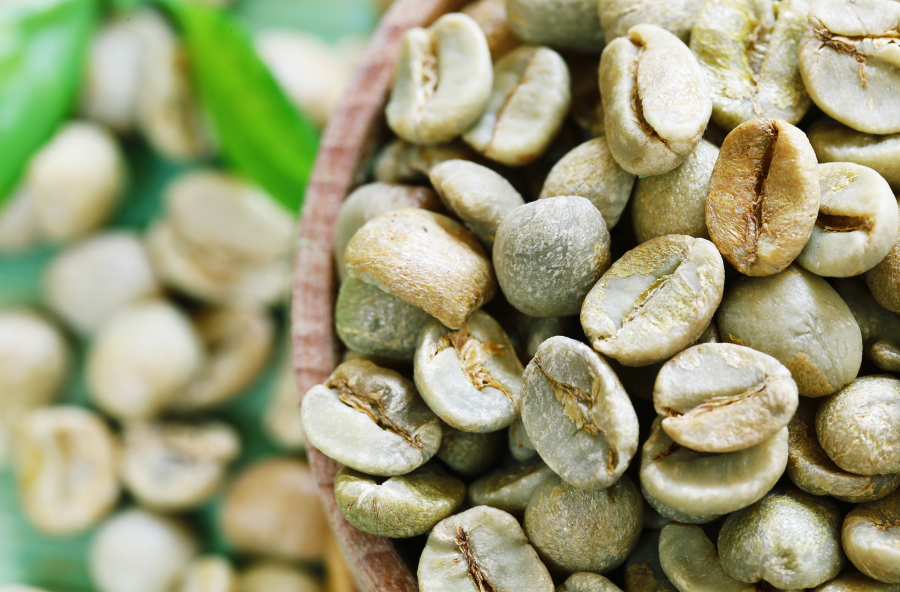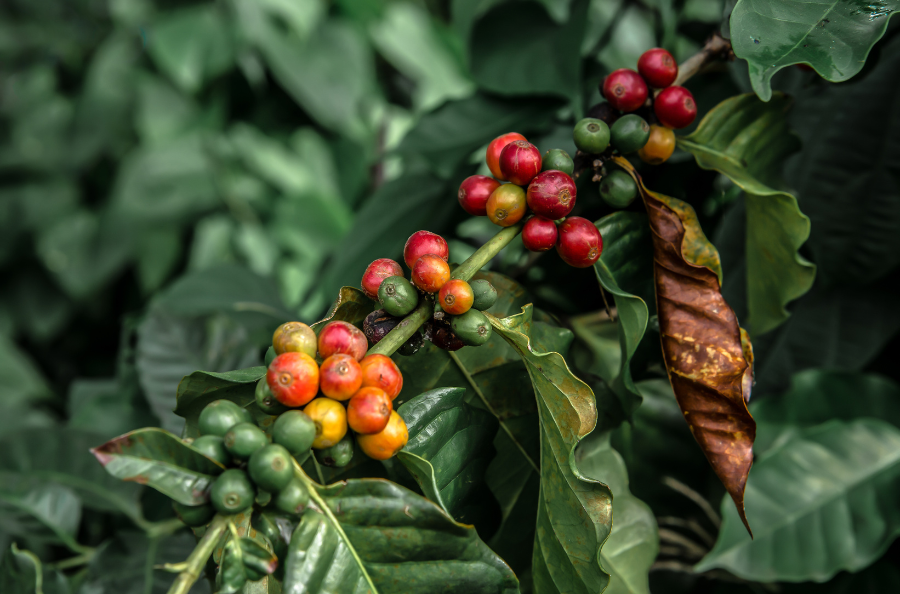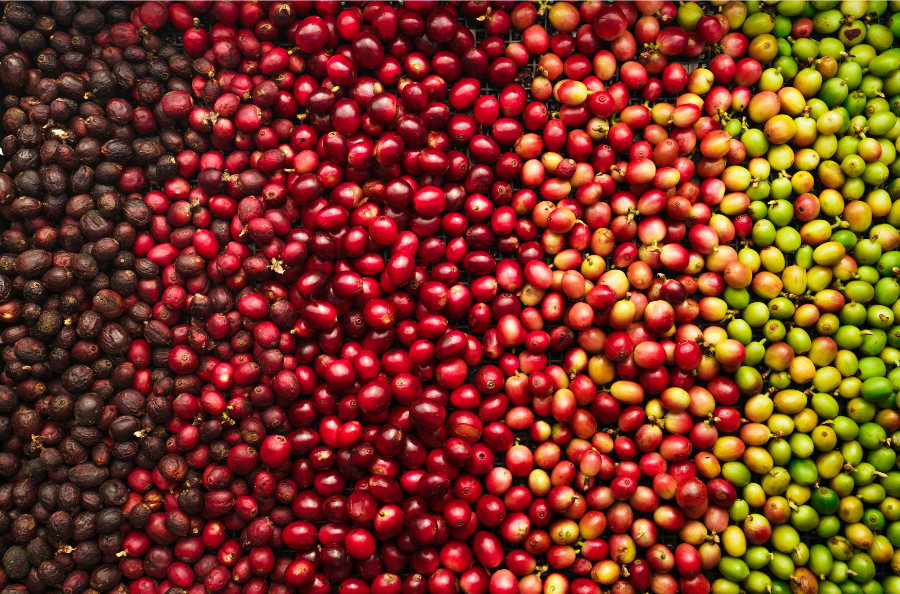Coffee 101
New to Coffee? Let's start with the basics.
Light Roast: Light roast is perfect for those who enjoy a crisp and nuanced taste experience.
Medium Roast: Medium roast beans are roasted to a medium brown hue, resulting in a well-rounded and flavorful cup.
Medium to Dark Roast: Medium to dark roast captures the best of both worlds, showcasing the complexities of a medium roast while venturing into deeper flavor territories.
Dark Roast: Bold and Intense for coffee enthusiasts who crave a bold and robust flavor profile.
Decaffeinated vs. Caffeinated Coffee: Decaffeinated coffee has come a long way in terms of flavor while there may be slight differences in flavor
TLDR Much? Consider downloading our comprehensive e-book!
A beginner’s guide to Choosing,
preparing, and enjoying a great cup of coffee.

Start with Great Coffee
Brewing the perfect cup of coffee is an art, and at Beachfront Java, we want to help you master it. Don't be intimidated. The perfect coffee profile will vary individual to individual. Whether you're using a drip coffee maker, a French press, or a pour over method, we have tips and guidelines to help you get the most out of your coffee. From water temperature to grind size, we've got you covered.

Roasting
Roasting Specialty-Grade coffee involves carefully selecting high-quality green coffee beans and using a roaster to apply heat to the beans in order to bring out their flavor characteristics. There are a few different approaches to roasting coffee, and the specific technique used will depend on the type of roaster being used and the desired outcome.
Here are the general steps involved in roasting Specialty-Grade coffee:
-

Green Coffee
Start by selecting high-quality green coffee beans. Look for beans that have been sourced from a specific region or farm, as these tend to have unique flavor profiles.
Next, decide on the roast profile you want to achieve. Different roast levels (light, medium, dark, etc.) will bring out different flavor characteristics in the beans.Preheat the roaster to the desired temperature.
Once the roaster is heated, add the green coffee beans to the roaster.
As the beans roast, they will go through several stages, including the drying stage, the Maillard stage, and the development stage. During the drying stage, the moisture in the beans is evaporated. In the Maillard stage, the beans begin to turn brown and develop flavor compounds.
In the development stage, the beans continue to roast and develop their flavor.
-

Roasting
The length of time that the beans are roasted will depend on the desired roast profile. Light roasts are typically roasted for a shorter period, while dark roasts are roasted for a longer period of time.
Once the beans have reached the desired roast level, they should be removed from the roaster and allowed to cool.
After the beans have cooled, they can be ground and brewed to produce a cup of specialty coffee.
It's important to note that roasting coffee requires a certain level of skill and knowledge, and it can be challenging to get the roast profile just right.It may take some trial and error to find the perfect roast for your taste.
The size of the batch and the temperature setting of the roaster will depend on the specific roaster being used and the desired outcome. -

Temperature
As for temperature, the temperature setting of the roaster will depend on the type of roast desired.
Light roasts are typically roasted at lower temperatures (around 400-410°F / 204-210°C), while dark roasts are roasted at higher temperatures (around 430-450°F / 221-232°C).
The specific temperature setting will also depend on the type of roaster being used and the characteristics of the green coffee beans.
It's important to note that the temperature of the roaster is just one factor that affects the final flavor of the roasted coffee.Other factors, such as the length of time the beans are roasted and the rate at which the beans are cooled, can also have an impact on the final flavor of the coffee.

Brewing
Now that you have quality roasted coffee to brew, the best method for brewing coffee will depend on your personal preference and the specific grind of coffee being brewed.
Some common methods for brewing coffee include:

Drip Brewing
This method involves brewing coffee using a drip coffee maker, which drips hot water over ground coffee to extract the flavors and oils.

French Press
This method involves brewing coffee using a French press, which is a cylindrical glass or stainless-steel pot with a plunger and a metal or nylon mesh filter. To brew coffee using a French press, hot water is added to the pot along with coarsely ground coffee, and the mixture is allowed to steep for a few minutes before the plunger is pressed down to separate the coffee from the grounds.

Pour-Over
This method involves brewing coffee using a pour-over device, such as a Chemex or Hario V60, which is a cone-shaped filter holder that sits on top of a carafe or mug. To brew coffee using a pour-over, hot water is poured over the grounds in a circular motion, allowing the coffee to drip through the filter into the carafe or mug.

Aeropress
This method involves brewing coffee using an Aeropress, which is a handheld device that uses a combination of air pressure and a paper filter to extract the flavors and oils from the coffee. To brew coffee using an Aeropress, hot water is added to the device along with finely ground coffee, and the mixture is stirred and pressed through a paper filter to create a concentrated brew.

Espresso
This method involves brewing coffee using an espresso machine, which uses high pressure to force hot water through finely ground coffee to extract a concentrated, flavorful shot of coffee.
A word about Water Temperature
The ideal temperature for brewing coffee will depend on the specific brewing method being used and the type of coffee being brewed. However, in general, the water used for brewing coffee should be heated to around 195-205°F (90-96°C). This temperature range is hot enough to extract the flavors and oils from the coffee beans, but not so hot that it will burn or scorch the beans.
If the water is too cool, it will not extract enough of the flavors and oils from the beans, resulting in a weak and underdeveloped flavor. On the other hand, if the water is too hot, it can burn the beans and create an unpleasant, bitter taste.
For most brewing methods, it is best to use water that has been heated to around 200°F (93°C). This will allow you to extract the maximum flavor and complexity from the coffee beans and produce a balanced, full-bodied cup of coffee.
It is also worth noting that the brewing temperature can vary depending on the specific brewing method being used. For example, some methods, such as the French press, may require slightly cooler water to avoid over-extracting the coffee and producing a bitter taste. In these cases, it may be necessary to adjust the brewing temperature slightly to achieve the desired results.

Above Sea Level
Brewing coffee at higher elevations can be a bit trickier because water boils at a lower temperature as the elevation increases. This can affect the extraction of flavors from the coffee grounds, resulting in a weaker or under-extracted brew.
One way to counter this is to use a slightly coarser grind and a longer brew time to allow the water more time to extract the flavors. You can also try using slightly more coffee to compensate for the lower extraction rate. It's also a good idea to keep an eye on the water temperature to make sure it's hot enough for proper extraction.
Some people find that a French press or AeroPress works well for brewing coffee at high elevations because the longer brew time and immersion of the grounds in the water can help to extract more flavors.

Coffee Origins
There is no one "best" origin of coffee to brew at higher elevations. The flavor profile of a coffee is determined by a variety of factors including the type of coffee bean, the roast level, and the growing conditions.
Some people may prefer a light roast coffee from Ethiopia, while others may prefer a dark roast coffee from Sumatra. Ultimately, the best coffee for you will depend on your personal taste preferences.
That being said, there are certain origin regions that are known for producing high-quality coffee.
For example, coffee from the Yirgacheffe region of Ethiopia is known for its floral, citrusy flavors and clean finish.
Coffee from the Kona region of Hawaii is known for its rich, smooth flavor with notes of chocolate and nuts.
Coffee from the Blue Mountains of Jamaica is known for its sweet, fruity flavors and balanced acidity.
Ultimately, the best coffee for you will depend on your personal taste preferences.
-

Coffee is grown in many countries around the world, but the majority of coffee is produced in developing countries in the so-called "Coffee Belt", which is a region that stretches around the equator and includes parts of South America, Central America, and Africa. Some of the
main coffee-producing countries include Brazil, Vietnam, Colombia, Indonesia, Ethiopia, India, and Mexico.These countries are responsible for the majority of the
coffee that is exported around the world and consumed by people in different countries.Coffee is also grown in other countries outside of the
Coffee Belt, including the United States, China, and several countries in Africa and Asia. In these countries, coffee is often grown on a smaller scale, either for local consumption or for export to other countries.It is not possible to provide a complete list of all coffee farms in the world, as there are thousands of coffee farms in many different countries, and this information is constantly changing. However, here is a list of some of the main countries that produce coffee and are known for their coffee farms
-

Vietnam: Vietnam is the second-largest producer of coffee in the world, and most of its coffee is grown in the Central Highlands region.
Colombia: Colombia is one of the top coffee-producing
countries in the world, and its coffee is known for its high quality. Most of the country's coffee is grown in the Andean region.Indonesia: Indonesia is a major producer of coffee,
particularly in the islands of Sumatra and Java. The country is known for its production of specialty coffee, such as Sumatran coffee and Java coffee.Ethiopia: Ethiopia is the birthplace of coffee and is one of
the top coffee-producing countries in Africa. Most of the country's coffee is grown in the highlands of the Sidama, Kaffa, and Harar regions.India: India is a significant producer of coffee, with most
of its production coming from the states of Karnataka, Kerala, and Tamil Nadu.Mexico: Mexico is a significant producer of coffee, with
most of its production coming from the states of Chiapas and Veracruz.These are just a few examples of the countries that produce coffee and have coffee farms.
There are many other countries that also produce coffee, including Honduras,
Guatemala, and Peru, among others

Rating Coffee
Premium or Specialty coffee is a term used to describe high-quality coffee that has been graded 80 or above on a 100-point scale by a trained coffee taster, also known as a coffee cupper.
The grading process, known as "cupping," involves a series of standardized taste tests that are conducted by trained professionals to evaluate the quality and characteristics of a coffee.
During the cupping process, the coffee is brewed and tasted in a controlled environment, and various factors are evaluated, including the appearance, aroma, flavor, acidity, body, and aftertaste of the coffee.
The taster also takes note of any defects or imperfections in the coffee, such as off-flavors or sourness. The coffee is then given a score based on the overall quality of the coffee and its specific characteristics, with the highest scores being reserved for the best-tasting coffees. Specialty coffee is considered to be any coffee that scores 80 or above on the 100-point scale, and it is typically distinguished by its unique flavors, aromas, and other characteristics.
In addition to being graded by trained professionals, specialty coffee can also be rated and reviewed by consumers, who may provide their own ratings and reviews based on their personal preferences and experiences with the coffee. This can be done through online reviews, social media, or other means of sharing feedback about the coffee.
Coffee cupping, also known as "tasting," is a standardized process used to evaluate the quality and characteristics of coffee. It is a sensory evaluation method that involves brewing and tasting coffee in a controlled environment in order to assess its appearance, aroma, flavor, acidity, body, and aftertaste.
The cupping process typically begins with a visual inspection of the coffee, during which the taster looks for any defects or imperfections in the beans. The beans are then ground and brewed using a specific method, typically using hot water and a small amount of coffee to create a concentrated brew.
After the coffee has brewed for a specified period of time, it is poured into cups and allowed to cool for a few minutes. The taster then uses a spoon to break the crust of the coffee and release the aromas and begins the tasting process by slurping the coffee from the spoon and taking a small sip.
This allows the taster to evaluate the coffee's appearance, aroma, flavor, acidity, body, and aftertaste. Coffee cupping is typically conducted by trained professionals, who use a standardized scoring system to evaluate the coffee and assign it a score based on its overall quality and specific characteristics.
The scores are used to determine the grade of the coffee and to help coffee roasters, buyers, and consumers determine the quality of different coffees.






